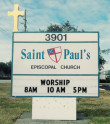'Sightless Among Miracles'
Text: John 20:1-18

Sunday Sermon
The Rev. Dr. D. William Faupel
Priest-in-Charge
Apr. 16, 2017
Introduction
“I was sitting in seat 1-D. We had just taken off when I heard the jet engines go dead. The plane was eerily silent as we glided rapidly toward the ground My mind raced with thoughts about my family, my work as my whole life passed before my eyes. I saw all the people I wanted to reach out to, all the fences I wanted to mend, all the priorities that had gotten skewed. I knew I was about to die, and now I knew I had spent so much of my life on things that did not matter.”
Rick Elias did not die on that cold January afternoon in 2009. The piolet, Chesley Sullenberger, or “Sully” as he was known to his friends, guided US Airways Flight 1549 to a safe landing on the Hudson River. I am sure all of you remember reading about that miracle landing.
I came across Elias’s story as I prepared for this morning’s sermon. It brought to mind a prayer, I once heard when I went with a Jewish friend of mine to synagogue back when I was in college. It began something like this: “Days pass, and the years vanish, and we walk sightless among miracles.”
As I reflected on the Easter story, told not just by John which was just read this morning, but also by Matthew, Mark and Luke, this prayer frames my approach as reflect together. At its heart, the Easter story is a day full of miracles. Like Christmas, the choir makes magnificent music, the preacher speaks or resurrected life with confidence, we make bold affirmations of faith. Yet, I suspect, many of us wonder: “Is Easter really true?” Miracles, as the Jewish prayer implies, are not always easy to recognize.
I.
For many of you, I suspect, Easter is a hard day rather than a happy one. Once it was filled with joy and many happy memories. But as the years go by, one by one the persons with whom you shared those memories are gone. On this day for many, the loss of companionship, and the sense of loneliness is intensified. Still, you are here this morning, decked out in your Easter finest. You are here, hoping that you can recapture some of the joy and wonder that you experienced when you were you younger. May God grant you that wish.
For others of us, we have been so busy preparing for Holy week and Easter, that we have not taken the time to really prepare our hearts and our minds to fully experience the reality of this miraculous day we celebrate today. This is especially an occupational hazard for us clergy. This past Tuesday, for example, I joined the clergy of this diocese to renew the vows I made at my ordination. At lunch afterward, I did not hear one comment about how much a clergy person was looking forward to celebrating Easter. All the comments were directed at what each of us was planning to do next week to relax and recover. Our Lord understands this reality, may He surprise each of us by allowing us a renewed sense of the miracle of resurrection.
Still others may be here today who are living in the shadows. They are weighed down by great grief that lay heavy on the heart; by unsettling fears, both large and small; by nagging feelings of guilt, recalling something done or left undone; by a corrosive bitterness that eats away at the soul; or by debilitating doubts that stand out in such stark contrast to the confident hymns and sturdy prayers of Easter Sunday. For you I pray the miracle of faith renewed.
II.
If perchance you find yourself fitting into any of these categories this morning, don’t despair. You are not alone. I suggest that we look at the response of those who were present on that first Easter morning. We find that their first responses were very similar to ours. As I look at the accounts in all four Gospels, what strikes me is just how lacking in confidence every one of the first witnesses was. As one of my professors once stated in class: “The wonder of the resurrection stories in the Scriptures is that they reveal the disciples’ total resistance in coming to terms with the reality of the Risen Christ.” Eventually they found their voices and began to sing their alleluias, but not at first.
Although all four accounts differ in many respects, one element of similarity stands out: “total skepticism.” When Mary Magdalene finds the grave empty, in today’s gospel, she assumes someone has carried the body away. The disciples, behind locked doors, did not recognize Jesus when suddenly he stood among them. Thomas refused to believe them when they later told him that their Lord had risen from the dead. The two on the Emmaus Road did not recognize him even though he traveled with them some distance and opened the meaning of the scriptures to them.
Why? Because in large part they believed Jesus was, in the way of mortals, dead and gone. When we have a funeral, we pay our respects and then we go on with our life as best we can. That is all that Mary was doing that morning when she went to the tomb. She was saying a final good-bye. It was still dark, but even from a distance she sensed something was wrong. She could smell the damp earth and cold rock from inside the tomb. Someone had move the stone! Afraid that Jesus would become a martyr or that his grave would become a shrine, someone had stolen his body. God alone knew where, perhaps it was thrown over a steep cliff or in the town dump. His body was all that she had left and now it too was gone.
She ran to tell Peter and John. They came and peered into the tomb. They saw the cloth that once wrapped his body and his thorn-pierced head. They came to the same conclusion as Mary. Someone has stolen the body. So, they go back to town leaving Mary alone, unconsoled, weeping, in the garden.
Finally, she got up enough nerve to go back to the tomb and this time, like Peter and John, actually look in. Instead of seeing the burial clothes, she sees two angelic figures. They ask her why she is weeping. She replied: “They have taken away my Lord and I don’t know where they have laid him.”
In the other three gospels, Matthew, Mark and Luke, the angelic figures then interpret the meaning of the empty tomb. “Do not be afraid,” they say, “you are looking for Jesus of Nazareth, who was crucified. He is not here. He has been raised from the dead. Go, tell the disciples that he is going ahead of you to Galilee. There you will see him.” But here in John’s Gospel, after asking why she is crying, they are silent.
Then another unexpected thing happens. Mary hears a noise behind her. She turns to see a man standing behind her. She does not recognize him and thinking he is the gardener says to him: Sir if you have carried him away, tell me where you have laid him and I will take him away. That was when he spoke the word that changed her life forever. He called her by name: “Mary.”
This is the same Jesus who during his ministry said: “I am the Good Shepherd and my sheep know my voice and I call my sheep by name. Now, in the garden, the Good Shepherd speaks, and suddenly the cloud of grief is lifted and Mary responds in recognition: “Rabboni (my teacher). In hearing her name spoken, Mary’s faith is formed. The empty tomb had not brought her to faith or even to a hint at the possibility of resurrection. Instead had only brought sadness and led her to conclude his body had been stolen. The appearance of two angels did not break her sorrow. Even the face of Jesus or his voice when he asked her why she was weeping, failed to stir recognition or faith within her. She certainly was not expecting a miracle. Only when Jesus called her by her name did she believe.
At that moment, a new expectation was created. Jesus was back! Perhaps things would return to normal once again. But Jesus once more does the unexpected. As Mary turns toward him, he said, “Do not hold on to me.” No matter how much she and the other disciples may have wanted life back the way it had been with Jesus before Good Friday, Jesus made it clear that he would now be relating to them in a different way.
Something else in his response was also unexpected. Not only was he not back with them in the way they might have wanted, now he was looking to the future. “I must go to my Father. Go tell this to my brothers.” He was facing forward and he was telling Mary and his disciples to face forward also. They were to live and lean in to a new reality, that his resurrection now made possible.
Conclusion
So too, for us today. In the midst of all our circumstances be they filled with joyous memories or painful moments, it is my prayer that this day, you will feel the Master’s presence afresh and anew as he calls us each by name and find your faith renewed so that with me you can say with confidence and joy, “Christ is Risen, The Lord is risen indeed!”
SUPPORT ST. PAUL'S DONATE NOW OR RECURRING DONATION

3901 Davis Blvd., Naples, Florida 34104 239-643-0197 Office hours 9 a.m. to 1 p.m. Monday-Friday


